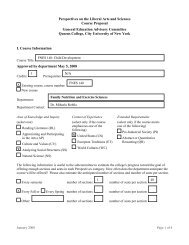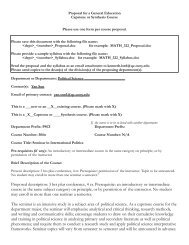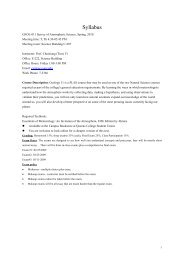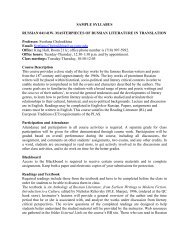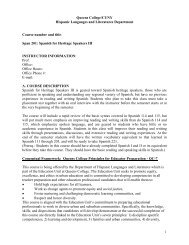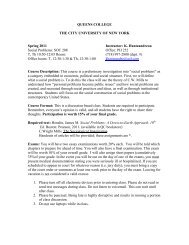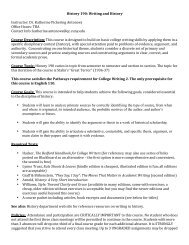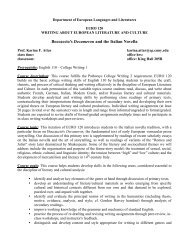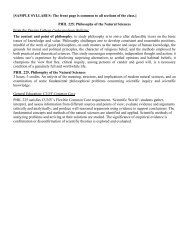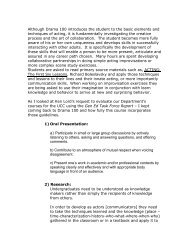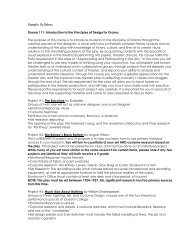HNRS 125 - Queens College Academic Senate - CUNY
HNRS 125 - Queens College Academic Senate - CUNY
HNRS 125 - Queens College Academic Senate - CUNY
You also want an ePaper? Increase the reach of your titles
YUMPU automatically turns print PDFs into web optimized ePapers that Google loves.
<strong>HNRS</strong> <strong>125</strong> FALL 2011<br />
<strong>Queens</strong> <strong>College</strong> Professor M. Healey<br />
Office Hours: M/F 12:15-1:30 meghanhealey@hotmail.com<br />
Office is located in COLWIN HALL 410-411<br />
HONORS <strong>125</strong>: THE ARTS IN NEW YORK CITY<br />
Seminar 1 explores the diverse arts in New York City. During the semester,<br />
students attend performances and exhibits of the current cultural season.<br />
In addition to the four genres (opera, dance, theater, and the visual arts)<br />
covered in all sections of the Seminar, faculty choose from a variety of<br />
textual, photographic, musical, and performance genres. Students tackle<br />
such questions as: What does each genre offer? How does each speak to<br />
us? How does art create, serve, and represent the people of the city and<br />
its diverse communities? Aesthetic appreciation is supported by social<br />
and historical investigations so that students are provided with<br />
opportunities for different kinds of engagement with art forms, including<br />
interpretation, analysis, and creative endeavors. The culminating event of<br />
the Seminar, Snapshot NYC, is an ongoing accumulation of photographs<br />
of student views of New York City.<br />
This semester, we will explore artists’ contrasting views of New York City-<br />
light and dark, rich and poor, insider and outsider- and discuss our<br />
community’s role in the larger American culture as iconic dreamland and<br />
urban blight. You will be asked to write and reflect on the work you see, as<br />
well as create your own original work that reflects your view of this<br />
particular cultural moment in New York City.<br />
UPTOWN AND DOWNTOWN: HAVES AND HAVE NOTS?<br />
CLASS #1 (8/29):<br />
Introduction and Discussion of the Syllabus<br />
Discussion of performances and assignments, and proper etiquette<br />
for performances.<br />
o Assignments for next class:<br />
1. READINGS:<br />
• What is Theater? Reading: handout from class<br />
2. PERFORMANCES:<br />
• Anthony Caro on the Roof, Metropolitan Museum<br />
of Art- FRIDAY 9/2 at 7PM<br />
• Theater for a New City Street Festival, Washington<br />
Square Park- Sunday 9/11 at 5PM<br />
3. FILMS:<br />
• Manhattan (Allen, 1980)<br />
4. BLOGS:<br />
1
• BLOG #1 (Due Sunday 9/4 by 12am): Give your<br />
impressions of the theater day performance. Did<br />
you enjoy it? Why or why not? Did this<br />
performance qualify as art? What does that word<br />
mean to you?<br />
• BLOG #2 (Due TUESDAY 9/13 by 12am): Compare<br />
the experience at Anthony Caro to the Street<br />
performances we attended. How did each<br />
reflect on stereotypical ideas of uptown and<br />
downtown art? Which fit into your idea of art,<br />
and which did you like most?<br />
CLASS #2 (9/12):<br />
We will discuss how to meaningfully evaluate a live performance<br />
Discussion of the performances and the film and how they related<br />
to the readings. What do the terms “uptown” and “downtown”<br />
mean? How do artists portray these communities?<br />
o Assignments for next class:<br />
1. READINGS:<br />
• God of Carnage by Yasmina Reza<br />
2. PERFORMANCES:<br />
• The Bald Soprano at The Pearl Theater- date TBD<br />
3. BLOGS:<br />
• BLOG #3: Review the performance at the Pearl.<br />
How did the performance speak to a New York<br />
Audience? (DUE MONDAY 9/19 12am)<br />
CLASS #3 (9/19):<br />
Discuss The Bald Soprano, particularly how the play was similar or<br />
different from God of Carnage. How do the plays and the film you<br />
saw portray people of a privileged economic class? Discussion of<br />
Photojournal Project and a short history of photography.<br />
o Assignments for the next class:<br />
1. READINGS:<br />
• In Arabia We’d All Be Kings by Stephen Adley<br />
Gurgis<br />
2. FILMS:<br />
• Taxi Driver (Scorsese, 1979)<br />
3. BLOG #4: Is there an image or artwork that you think<br />
epitomizes your idea of “Uptown”/wealthy New York?<br />
What is it and why do you think this image has meaning<br />
to you?<br />
4. Your photo journal is due every Sunday at midnight<br />
from now until 12/1. Please include this assignment in<br />
your weekly plans from now on.<br />
CLASS #4 (9/26):<br />
2
We will compare and contrast the portrayals of economic class in<br />
the plays, films, and artworks that we have viewed. Where do you<br />
see yourself in this spectrum? How accurate were these portrayals?<br />
o Assignments for the next class:<br />
1. FILMS:<br />
• Do the Right Thing (Lee, 1990)<br />
2. PERFORMANCE:<br />
• New Music Tuesday at INTAR New York (500 52 nd<br />
Street @ 10 th Avenue) 7:30 PM 9/27<br />
3. BLOG #5: <strong>Queens</strong> is the most diverse borough in New<br />
York City, and one of the most diverse communities<br />
anywhere. To what cultural or ethnic communities do<br />
you belong? Is there an artwork (it can be a song, a<br />
piece of fine art, a dance, or a performing art piece)<br />
that has a special significance in your culture? What is it<br />
and what does it signify to you?<br />
CITY OF IMMIGRANTS: ART AND ETHNICITY IN NEW YORK CITY<br />
CLASS #5 (10/3):<br />
We will be discussing the significance of artworks that relate to and<br />
reflect cultural and ethnic identity. How have different immigrant<br />
groups added to the culture of New York City? How do they create<br />
a new culture that fuses their identities to the city as a whole? We<br />
will also have a discussion of the role of fine art in culture.<br />
o Assignments for next class:<br />
1. READINGS:<br />
• Art and Politics Reading (handed out in class)<br />
• Yellow Face by David Henry Hwang<br />
2. FILM:<br />
• Maria Full of Grace (Marston, 2004)<br />
3. BLOG #6: Video Blog! This is an open topic blog for you<br />
to speak about any topic (that relates to this class) that<br />
you have something more to say about.<br />
CLASS#6 (10/17):<br />
Many of the films and plays that we have watched and read in this<br />
unit are addressing racial stereotypes and prejudices. How can art<br />
comment on or address social issues such as racism? Is art an<br />
effective way of bringing attention to these issues?<br />
o Assignments for Next Class:<br />
1. READINGS:<br />
• A View from the Bridge by Arthur Miller<br />
2. PERFORMANCE:<br />
3
• Asuncíon at Rattlestick Playwright’s Theater<br />
(10/19 @ 8PM)<br />
3. BLOG #7: Review of Asuncíon. Was the play effective?<br />
Why or why not?<br />
CLASS #7 (10/24):<br />
In this class we will reflect on what way the portrayals of immigrant<br />
experiences in New York compare and contrast with the views of<br />
rich and poor in New York?<br />
1. READINGS:<br />
• The Matchmaker by Thornton Wilder<br />
2. FILM:<br />
• In America (Sheridan, 2004)<br />
3. BLOG #8: What was the piece from our unit on<br />
immigrant views of New York that affected you the<br />
most and why?<br />
CITY OF DREAMS OR URBAN NIGHTMARE?<br />
Class #8 (10/31):<br />
Of the millions of people who have immigrated to New York City,<br />
thousands were drawn here to pursue a dream. We will discuss the<br />
view of New York as an iconic place, versus the reality of New York<br />
City.<br />
o Assignments for next class:<br />
1. READING:<br />
• Kindness by Adam Rapp<br />
• Opera Reading (handout in class)<br />
2. EXHIBITS:<br />
• Intervals: Nicola Lopez (Guggenheim Museum)**<br />
• **PLEASE NOTE this exhibit closes on 10/25<br />
3. BLOG #9: New York Neighborhoods blog. This<br />
assignment will be passed out in class.<br />
Class #9 (11/7):<br />
We will discuss and show video from your New York Neighborhoods<br />
assignment. Why is New York such an iconic image in art and<br />
popular culture? What is it about New York that captures the<br />
imaginations of such a diverse body of people? We will choose<br />
groups for your multimedia final project and you will have a<br />
chance to discuss inhabited in your groups.<br />
<br />
o Assignments:<br />
1. READING:<br />
• inhabited by Michael John Garcés (will be<br />
distributed in class)<br />
2. PERFORMANCE:<br />
4
• Don Giovanni at the Metropolitan Opera<br />
TONIGHT!!!!!! 11/7 at 8PM<br />
3. BLOG #10: What did you think of Don Giovanni and the<br />
opera experience? First address how successful you<br />
thought the performance was in appealing to a young<br />
opera viewer such as yourself. Second- how did your<br />
opera experience reflect the ideas that we have been<br />
discussing about New York as a fantasy/nightmare?<br />
Class #10 (11/14):<br />
We will discuss the performance of Don Giovanni and Opera as an<br />
art form.<br />
o Assignments:<br />
1. READING:<br />
• The Mercy Seat by Neil LaBute<br />
2. FILMS:<br />
• Fahrenheit 9/11 (Moore, 2003)<br />
3. EXHIBITS:<br />
• 9/11 Peace Story Quilt at the Metropolitan<br />
Museum of Art (view This by 12/5)<br />
4. BLOG #11: Is New York your Eden? Or your inferno?<br />
Class #11 (11/21):<br />
We will discuss the plays and films you viewed/read in this unit and<br />
how these images of New York relate to the views of New York we<br />
viewed in the previous unit in the first half of class. In the second<br />
half of class you will have a work session in your groups to finalize<br />
your storyboard which is due next week.<br />
o Assignments:<br />
1. Finish your storyboards. Make your shooting schedule<br />
and secure your locations. You should have your<br />
costume and production designs prepared, finish your<br />
casting.<br />
Class #12 (11/28):<br />
We will see and discuss each group’s storyboard and concept. You<br />
will have a chance to present your proposal and then discuss the<br />
feedback in your groups.<br />
o Assignments:<br />
1. READING:<br />
• Final Reading (handout in class)<br />
2. PERFORMANCE:<br />
• Supernatural Wife (BAM 11/30 8PM)<br />
3. BLOG #12: How did the events of 9/11 change<br />
people’s perceptions of New York? Is it more<br />
meaningful to the people of New York City than to<br />
others who do not live here? Can artists truly portray<br />
5
the traumatic events of that day in a meaningful way?<br />
Why or why not?<br />
4. PHOTOJOURNAL:<br />
• Your photojournal ends this week. The last photos<br />
will be posted on 12/4.<br />
Class #13 (12/5)<br />
We will discuss how the 9/11 artworks attempt to address political<br />
events through art. You will have time in class to have a meeting<br />
with your group to work on editing your film.<br />
o Assignments:<br />
1. PHOTOJOURNAL: Choose your favorite image from your<br />
journal, and bring a hard copy of it to class.<br />
2. BLOG #13: Final blog. Reflect back on all the works you<br />
saw this semester and all the different ways and images<br />
that were portrayed of New York City. Which work was<br />
your favorite? Which view of New York City is the one<br />
you find most truthful?<br />
Class #14 (12/12)<br />
Final class. We will wrap up the work we have been doing this<br />
semester with one final discussion and meditation on how place is<br />
portrayed through the lens of art in various media.<br />
o Assignments:<br />
1. FINAL PROJECT IS DUE NEXT WEEK.<br />
GRADING POLICIES AND CLASS GUIDELINES:<br />
o Arts in NYC Blog- 40 % of your grade<br />
Your blog will be graded on several factors:<br />
1. Quality and clarity of ideas<br />
2. Concise and clear expression of arguments<br />
3. The progress of your blog over the course of the semester- meaning<br />
your blogs and ideas should improve in quality as we go on, not<br />
diminish as you get busy later in the semester.<br />
4. Completion and submission of your blog no later than midnight<br />
each Sunday before class.<br />
There are alternative Blog topics in the event you are forced to miss a<br />
performance that you were assigned to blog. Please see me ASAP if you<br />
need to complete the alternative. Your blog will be critiqued every three<br />
weeks during the semester, more if you are struggling. You should try to<br />
respond to the suggestions given in your critique, and be consistent in your<br />
blog. Each blog should not exceed 1.5-2 pages as a word document.<br />
o Photojournal Project- 25 % of your grade<br />
6
Your photojournal project will be critiqued along the same guidelines as<br />
your blog:<br />
1. Quality of the images<br />
2. Choice of images- are you finding unusual ways to tell your visual<br />
story, are you improving the quality of your images as time goes on?<br />
3. Narrative Clarity- Are you telling a story through images?<br />
4. Completion in a timely manner- meaning that the Tech and I can<br />
see that you are uploading images NO LESS than 2 times a week,<br />
meaning that you are ACTUALLY KEEPING A WEEKLY<br />
PHOTOJOURNAL, NOT JUST TAKING A BUNCH OF PHOTOS EVERY<br />
MONDAY AND UPLOADING THEM TO YOUR JOURNAL. I warn you that<br />
I will know if this is what you are doing, as it will not result in quality<br />
work, and it defeats the educational purpose of this project.<br />
o Multimedia Final Project- 20 %of your grade<br />
o Meet the Artists-- The Honors <strong>College</strong> requires you to attend at least<br />
one of their common events in the Meet The Artists Series. THIS IS<br />
MANDATORY AND NON-NEGOTIABLE. The list of the events will be<br />
posted on E-portfolio and you can attend any event of your<br />
choosing. Make sure you register for events you want to attend in<br />
advance, since some professors will take their class as a group and<br />
space at your desired event may be limited. You are required to<br />
sign in at the event as proof of your participation, and you must<br />
provide me with the date and name of the event you attended no<br />
later than 12/5.<br />
o Class Participation-15 % of your grade--Class participation<br />
encompasses- but is not limited to- regular class attendance.<br />
Excellence in class participation means arriving in class on time, with<br />
your work prepared, attending the performances and events- ON<br />
TIME- and being able to speak and offer your opinions without<br />
being prompted. Repeated absences (exceeding three in the<br />
semester) from class, repeated absences from performances and<br />
events, lack of preparation, and repeated lateness will have a<br />
negative effect on your grade.<br />
Policies regarding the Performances and Exhibits for class<br />
Your presence at the performances and exhibits that are arranged for this<br />
seminar is a required element of your participation in this course. In the<br />
course of the semester it may happen that due to illness, religious<br />
obligations, night classes, or other sudden circumstances you are not able<br />
to attend one of the performances or events. This is unfortunate, but<br />
sometimes there are circumstances beyond our control that must be<br />
7
addressed. If you have advance notice that you need to miss one of the<br />
performances, you should contact me ahead of time to try and arrange<br />
something. There are alternative blog topics if you need to make up for a<br />
performance that you have missed. Missing the performance does not<br />
excuse you from your blog assignments. You can also choose to attend<br />
the assigned performance on another date at your own expense. The<br />
only tickets that are available to you free of charge are the ones that<br />
Honors <strong>College</strong> has arranged for the performance dates listed on the final<br />
page of this syllabus. Repeatedly missing performances will have a serious<br />
negative effect on your grade in this course and will be reported to the<br />
Dean of Honors <strong>College</strong>. There is, of course absolutely NO TEXTING or<br />
phone use of ANY kind during the performances.<br />
We will meet in the lobby of the performance venue 20 minutes before<br />
the start of the scheduled performance. PLEASE BE VERY CAREFUL TO<br />
NOTE THE START TIME AND VENUE LOCATION OF EACH PERFORMANCE. We<br />
will enter the performance no later than 10 minutes before the show starts.<br />
IF YOU ARE LATE (MEANING YOU ARRIVE AFTER WE HAVE ALREADY ENTERED<br />
THE PERFORMANCE) THEN YOU ARE OUT OF LUCK, AND YOU WILL MISS THE<br />
PERFORMANCE.<br />
There are some fine art exhibits that you have been assigned to view on<br />
your own schedule. The date suggested under the “performances”<br />
section of your assignments is the suggested date on which to view the<br />
exhibit in relation to the lesson, but you are free to view it any time before<br />
we are to discuss the exhibit in class at your own convenience. PLEASE<br />
NOTE THE DATE BY WHICH YOU ARE TO VIEW THE EXHIBIT, AS WELL AS THE<br />
CLOSING DATE OF THE EXHIBIT. You can go together as a group or as an<br />
individual. Use your cultural passport to view the exhibits without<br />
additional charge.<br />
Your cell phone must be turned off (this includes texting) during all<br />
performances- - and while you are attending exhibits. Many museums will<br />
allow you to take non-flash photographs of the exhibits, with some<br />
restrictions. Please observe all rules and policies of the museums you visit.<br />
General Class Policies<br />
The use of cell phones in class is strictly and completely PROHIBITED.<br />
Please turn your phone to the “off” position, and store it inside your bag<br />
during class time. This means no texting, no checking your email, and no<br />
phone calls during class time- I do not want to hear your phone ring, I do<br />
not want to see you texting under your desk. If I find this happening, you<br />
8
will be asked to leave class, and you will receive a 0 grade for class<br />
participation that day.<br />
Laptop computers may not be used in class- except for giving<br />
presentations, and with permission during certain work sessions. During a<br />
work session all work on the computer must be specifically related to the<br />
project. If I find you surfing the web and checking emails during a work<br />
session, you will receive a 0 grade for class participation that day, and<br />
your laptop will be banned from future classes. Laptops may not be used<br />
for note taking. I apologize for this inconvenience, but the presence of<br />
wireless internet has proven to be an irresistible temptation to most<br />
students. You are welcome and encouraged to take all the notes you<br />
want, but you will need to do so using a pen and paper.<br />
One of the reasons for these rules is the importance of creating a positive<br />
atmosphere for class discussion. This can only exist in a class where you<br />
and your fellow students are focused and respectful of one another.<br />
Some of the works we will be reading and viewing can be provocative,<br />
controversial, and may even be offensive to some students. Your honest<br />
reaction to these works is your own, you do not have to agree with, or<br />
even like, what the artist is expressing- or what another student is saying<br />
about it. But a true dialogue is only possible when we respect one<br />
another’s differences and really try to hear different points of view. We<br />
also need to foster an atmosphere of trust and non-judgmental listening.<br />
Which means, what is said in class should stay in class, and students should<br />
not be afraid to speak their minds for fear that it will be discussed in other<br />
contexts.<br />
Thank you, in advance for respecting these guidelines.<br />
If you need to reach me, my primary email address, which appears on<br />
page one of this syllabus, is the best way. That is the email that comes to<br />
my phone and which I check throughout the day. My school email<br />
address is fine, but I do not check it every day. You can also call my office<br />
at 718-997-3192, but if no one answers, then I am not there, and it is also<br />
the costume shop phone so there is no voicemail. Some of you may note<br />
that on my hotmail email signature, my cell phone number is listed. Please<br />
respect that this number appears there because this is my primary<br />
business email, not as an invitation for you to call or text me on my cell<br />
phone. I am delighted to make an appointment to see you any time you<br />
have concerns about your work in class, or if you want to discuss a project<br />
with me one on one.<br />
9
The syllabus, and all other class documents, as well as lecture notes for<br />
class will be available to you on Eportfolio. I will also be emailing you as a<br />
group through the Eportfolio system, which means you need to check<br />
your school email address regularly, so that you do not miss important<br />
information.<br />
Our Instructional Technology Fellow (ITF) is Tsai-Shiou Hsieh and she can be<br />
reached at tsaishiou.hsieh@qc.cuny.edu for any problems with your blog<br />
or photo uploads.<br />
Texts for class:<br />
Reading Handouts: will be distributed in class free of charge<br />
PLAYS:<br />
God of Carnage by Yasmina Reza, In Arabia We’d All Be Kings by Stephen<br />
Adley Gurgis, Kindness by Adam Rapp, A View From the Bridge by Arthur<br />
Miller, Yellow Face by David Henry Hwang, The Mercy Seat by Neil La<br />
Bute, The Matchmaker by Thornton Wilder<br />
10
Photojournal Project <strong>HNRS</strong><strong>125</strong>: Arts in NYC<br />
Professor Healey meghanhealey@hotmail.com<br />
Photojournal Project Guidelines and FAQ’s<br />
Your Photojournal project is a five-week project, during which time you will<br />
try to tell your story using only images, which you capture or create. This<br />
project will be 20% of your final grade in this course, so this needs to be a<br />
well thought out project that you devote time to each week.<br />
General Guidelines<br />
1. The broad theme of the project is to tell your story- or to put a finer<br />
point on it- the story of your first semester (give or take) of school<br />
through images<br />
2. You should try to take 1 photo (or more if you like) each day<br />
a. This photo can be something that you capture<br />
spontaneously, or an image that you “create” or stage, or<br />
you could do a combination of the two. Examples of this<br />
include:<br />
i. Setting up a specific rule or guideline for yourself, such<br />
as taking a photo at the same time each day no<br />
matter where you are.<br />
ii. One student decided to take a photo of him sleeping<br />
somewhere strange each day, like the quad, or his<br />
bathtub, or on a statue. This would be an example of<br />
partly staging it (the sleeping) but being spontaneous<br />
(taking the photo wherever he was each day). He<br />
wanted to show that his spring break was all about<br />
getting some sleep.<br />
iii. Creating a theme for your project. You could choose<br />
your neighborhood, or green spaces in the city, or<br />
some other “theme” that you feel you will be able to<br />
develop over the course of the month. Whatever<br />
theme you choose should relate to you on a personal<br />
level.<br />
b. You should also feel free to leave things open, just keeping<br />
your eyes peeled for great images that you discover or come<br />
across.<br />
3. I strongly suggest that you try to take at least three pictures every<br />
day, so that you can have some choices in putting the pictures into<br />
your journal, as you craft your story through the five weeks. But only<br />
5 pictures per week are required.<br />
11
4. You need to do this daily, like writing in a journal, in order for the<br />
project to really work. It doesn’t work to just go out every Sunday<br />
and take a bunch of random photos and upload them to your<br />
journal. First, you are missing the point of the project, which is<br />
image-based storytelling over time, and second, that is not the<br />
assignment. I will be able to tell if that is what you are doing, and<br />
your poor grade will reflect the lack of effort in your project.<br />
5. You also need to balance your weekly photos with an eye for how<br />
the project will come together as a whole. Look at your photos<br />
together, and ask yourself- do I see a connection? Is there a story<br />
that emerges from this journal?<br />
6. I will view your photos and send you an email commenting on your<br />
progress in random order about once every other week.<br />
7. You need to be organized and vigilant about uploading your<br />
photos at least twice a week. If you have not uploaded your photos<br />
when I look at your page, you will be reminded to do so, and miss<br />
your opportunity for critique. If the tech fellow and I notice that you<br />
are always uploading on the same day once a week, we will have<br />
to assume that you are not following the guidelines of the project,<br />
and this will be reflected in your grade.<br />
8. This project is not a scrapbook, or a series of “yearbook photos” of<br />
you and your friends. You should approach this as an artistic<br />
endeavor, and strive to dig deeper into your ordinary life. You are<br />
not just documenting your story, you are also commenting on it, as<br />
the other artists whose work you will study this semester do. There is<br />
nothing wrong with having some photos of you, or your friends, or<br />
you with friends if you feel that a particular moment or image is<br />
important to your journal. But a journal that is just you and your<br />
significant other partying with friends is not going to make the cut,<br />
and you will be asked to change the theme and subject of your<br />
portraits. In other words- if your Photojournal starts to look like a<br />
wayward Facebook page, you’re in trouble.<br />
9. Your journal will be really boring if you just take a bunch of pictures<br />
of the junk that is sitting on your desk, or your furniture in your dorm<br />
room. And for the record- I have seen a lot of photos of pencils<br />
“artfully arranged” on a desk and “lonely” notebooks thrown on a<br />
dorm bed… You will definitely not impress me that way. Try to seek<br />
out original subjects for your photos, or take clichéd subjects and<br />
explore them in a new and meaningful way.<br />
10. Think about how your story fits into our larger theme of New York<br />
City through the lens of art. How does your experience here at the<br />
college change and shape your view of New York City? How can<br />
you capture the New York City of a <strong>Queens</strong> <strong>College</strong> Student<br />
through images?<br />
12
11. You will be graded on the originality, thoughtfulness, and clarity of<br />
your project, as well as how you progressed through the project.<br />
How well you took your critiques and incorporated suggestions and<br />
notes and whether you improve your eye for images are an<br />
important part of your grade on this project.<br />
12. If you are concerned about your project or need to discuss it, you<br />
can make an appointment to come and see me during my office<br />
hour. If you have issues uploading your photos, please contact our<br />
tech fellow at tsaishiou.hsieh@qc.cuny.edu<br />
13
MHC Seminar I: The Arts in New York City FALL 2010 Healey<br />
Guidelines for Blogging<br />
FAQ’s<br />
What is this blog about?<br />
This blog, which you will develop over the course of the semester, will be<br />
part a journal of your experiences in class and at the performances you<br />
attend, and part critique of the work you are seeing. Each blog as been<br />
assigned a particular theme or question, that asks you to both describe<br />
your reaction to what you have seen, and examine the place of these<br />
works in the community of New York City/the US/The world to the best of<br />
your ability.<br />
How long should my Blog be?<br />
Blog writing can seem easier than writing a paper- at first. But, in actuality,<br />
writing a good blog is just as difficult as writing a lengthy research paper.<br />
You should think of your blog as being something that would be about 1-2<br />
pages long if it were a word document. Because of this, you need to be<br />
very concise with your writing, and really organize your thoughts. Often,<br />
students try to make their papers longer or pad out a weak or poorly<br />
researched idea with “filler” (i.e. long introductory paragraphs and<br />
frequent re-statement of the same idea). In Blog writing, it is best to avoid<br />
padding, and get straight to the substance of your argument.<br />
That being said, a blog that is only a couple of paragraphs long will tend<br />
only to superficial analysis, and won’t give a meaningful answer to the<br />
questions being posed. It also usually reflects a lack of effort on your part,<br />
so try to balance find a balance between excessive loquacity and a lack<br />
of detail.<br />
What are some tips for writing a better blog?<br />
Blog writing needs to make a clear point in a short amount of space, with<br />
well-defined arguments and a passionate point of view.<br />
You shouldn’t try to write what you think I want you to, or what you think is<br />
“correct.” The best blogs will speak about your personal experiences, and<br />
how these have influenced your view of the artworks you will view this<br />
semester.<br />
From a critical point of view, you should think of your blog as a way for<br />
you to enter the larger conversations that the art community is having<br />
about these works, and these issues. What do you have to add to that<br />
14
conversation? This is the kind of thinking that makes for original ideas and<br />
original ideas make for an exciting blog.<br />
There are several links to well known theater blogs under the heading<br />
“External Links” on our home page. These vary in content and style, and<br />
you are encouraged to read them both for information and education, as<br />
well as for inspiration. Remember that you cannot re-use any content from<br />
the blogs without crediting the source material.<br />
Can I use an idea/comment/quote from someone else in my blog?<br />
Yes. But you must cite your sources. Using a quote, an idea, or cutting and<br />
pasting something you found on the web into your blog without proper<br />
citations is plagiarism. If you are found to be plagiarizing portions of your<br />
blog, you will receive a 0 grade for this assignment, and you will face<br />
discipline from the university dean, which can include an automatic F in<br />
this course, and possible expulsion from <strong>CUNY</strong>. Plagiarism is a serious<br />
offense, so if you are using material you found somewhere else, err on the<br />
side of caution and always use quotes or end notes.<br />
Can I respond to something someone else wrote on their blog?<br />
YES. We have set up your blogs so that you can read and comment and<br />
keep a lively dialogue with one another. Please remember that the same<br />
guidelines of respect and listening that we use in class apply to the blogs.<br />
It’s okay to disagree with each other, but you have to back up your<br />
arguments with observations and facts- no snide comments and ad<br />
hominem attacks. It’s the Internet, but keep it articulate, keep it clean…<br />
If you think a point raised in someone else’s blog is relevant to a blog you<br />
are writing, then you can quote them. Please see the guidelines for<br />
plagiarism and citation above.<br />
Other guidelines/suggestions:<br />
You can write your blog from the point of view that the reader has<br />
already seen or read the artwork/play/film/dance piece that you are<br />
commenting on. This means there is not a need to summarize the plot or<br />
simply describe the artwork. You should be trying to engage with the<br />
piece and comment on it, not just offer a bland synopsis of what you saw.<br />
For plays or films, when writing a review, try to touch upon all of the<br />
following elements:<br />
1. Acting- what performances stood out to you, good or bad? If you<br />
thought they were good, what made them so? If you thought<br />
15
someone gave a bad performance, why (specifically) did you feel<br />
this way? Give examples of how the performance under discussion<br />
affected your view of the narrative.<br />
2. Directing- what was the concept of the work? Did the story and<br />
ideas come across clearly? How original was the idea?<br />
3. Writing- What did you think of the story? Was the narrative linear, or<br />
expressionistic? Did you relate to the characters? To the story in<br />
general? How original was the story?<br />
4. Mise-en-scene- Carefully observe the design elements of the piece,<br />
costumes, scenery, lighting, and sound. How are they working to<br />
help you understand the story (creating a sense of time, place,<br />
mood)? Go deeper than just saying “They’re pretty” Or “I liked it.”<br />
Did they support the production’s overall concept? How so?<br />
By examining all of these elements, you are digging deeper into these<br />
artworks and trying to understand two key elements- a) what was the<br />
artist’s intention with this piece? And b) were they successful in achieving<br />
that intention?<br />
While the emphasis of this class is not on proper English grammar, please<br />
remember that good writing is clear writing, and blogging is not an excuse<br />
for poor spelling, fragments, or incoherent structure. I will be commenting<br />
on grammatical errors, especially if they interfere with the overall quality<br />
of your blog.<br />
Try to improve the quality of your blogs as the semester progresses. I will be<br />
critiquing your blogs in random order every 3-4 weeks throughout the<br />
semester, more if you need it. Make sure to read other people’s blogs so<br />
you have a strong handle on what others are saying and doing, and also<br />
to offer inspiration for how you might improve your own blog.<br />
Your Blog is due Sunday at midnight each week. The subject of each blog<br />
is listed under the assignments section of your syllabus in the previous<br />
week. Late blogs will not be accepted, and they will be deducted from<br />
your overall grade.<br />
Contact our trusty tech fellow Tsai-Shiou at tsaishiou.hsieh@qc.cuny.edu if<br />
you are having problems uploading information onto your blog, or if you<br />
experience other technical glitches.<br />
16
HONORS <strong>125</strong> FALL 2011 HEALEY<br />
MULTIMEDIA FINAL PROJECT ASSIGNMENT AND GUIDELINES<br />
In this project you will be the artist, and decide what role/roles you think<br />
your piece should attempt- Social Critic? Preserving your culture? Political<br />
Voice? You will use the text source material to create an original film. You<br />
will work in groups of four, and you will be evaluated for your work as a<br />
group and as an individual for your specific role within the group.<br />
PART I: FILM/THEATER COMPONENT<br />
Using the source text as your script, you must create a short film of the<br />
source material. Each of the group members should take on one of the<br />
assigned roles:<br />
• Director- Acts as director of the film, works with the designer to<br />
choose a palette and artistic scheme for the film, works with the<br />
Dramaturg to turn the source material into a screenplay, chooses<br />
the shots with the Cinematographer.<br />
• Production Designer- Chooses locations for the film, leads the group<br />
in putting together costumes and props, leads the group in<br />
transforming whatever space or spaces you choose for your film,<br />
works with Director to choose an aesthetic for the piece, helps<br />
cinematographer to choose shots at the location, does visual<br />
research to supplement the Dramaturg.<br />
• Cinematographer- The person who will be responsible for shooting<br />
the footage (meaning they will control the camera during the<br />
shoot, this is a good role if you do not want to perform in the film),<br />
this person will lead the editing of the film, works with the director to<br />
transform the storyboard of the film into life, works with the designer<br />
to create the film’s aesthetic, works with the Dramaturg to create<br />
the script.<br />
• Dramaturg- This person does research on the background<br />
information for the script, works with the Designer to choose visual<br />
research, works with the Director to help shape the script, is the<br />
primary force in shaping the script into a screenplay.<br />
COMPONENTS OF THE ASSIGNMENT:<br />
1. CHOOSE YOUR GROUP<br />
a. Choosing your group is an important part of the assignment.<br />
The best groups will not just be friends joining together, you<br />
should try to be in a group with individuals who balance each<br />
others strengths and weaknesses.<br />
17
. Once your group is chosen, assign roles within the group. If<br />
more than one person wants a role, try compromise or<br />
discussion, and if that fails try taking a vote. If you cannot<br />
come to an agreement then I will help you to decide.<br />
2. READ YOUR SOURCE MATERIAL<br />
You have been given a 10-minute play called inhabited* by<br />
Michael John Garcés. You may not change the dialogue as it is<br />
written in the play, but you should brainstorm with your team about<br />
how to interpret the material and turn it into a screenplay.<br />
*PLEASE NOTE: This is an unpublished work, which we are using for free with the permission<br />
of the author. You are not to share this script with people outside this class, and we do not<br />
have permission to perform it OUTSIDE of class without paying royalties to the author.<br />
Please respect these principles of intellectual property and use the script only for the<br />
purposes of the project.<br />
3. SCRIPT and STORYBOARD<br />
a. Your script and your storyboard are the first part of your<br />
project, and they are DUE ON 11/28. These are group<br />
components, so you need to work on them together, and<br />
you need to divide up the work equally. The script should be<br />
reformulated as a screenplay, and then it should be laid out<br />
visually as a storyboard.<br />
i. STORYBOARDS<br />
1. Your storyboard is almost like a comic book or<br />
graphic novel, laying out the shots and the story<br />
visually so that you can all look at and agree to<br />
your plan of action. You don’t need to lay out<br />
every single moment of the film, just the major<br />
action.<br />
2. Your storyboard can be hand drawn, created<br />
through photography, animated, or created on<br />
photoshop. Examine the skills of those in your<br />
group to determine the best method. Make sure<br />
that you all participate in creating the<br />
storyboard, in one way or another. For example,<br />
someone who likes to draw could draw the<br />
plates, someone else could photoshop them,<br />
someone else could take location photos to add<br />
to the storyboard, and another person can make<br />
sure that they follow the script.<br />
3. You will be asked to specify each person’s role in<br />
the creation of the storyboard.<br />
4. You may find that your finished film is different<br />
than your storyboard, and this is okay. Part of the<br />
creative process is discovering that what you<br />
18
thought would work doesn’t and adjusting to<br />
that process.<br />
4. CASTING AND SHOOTING YOUR FILM<br />
a. You will receive feedback on your storyboard, and then you<br />
can start shooting your film.<br />
b. Make sure that you work out your shooting schedule and<br />
scout your locations in advance. You do not need to wait for<br />
storyboard feedback to cast and arrange your location or to<br />
start shooting the film.<br />
c. You can cast other people in your film who are not group<br />
members. At least 2 group members must appear in some<br />
way in the film.<br />
d. You are allowed to have an animated film, or to use puppets<br />
to create the film if you choose.<br />
e. There must be some sort of music in your film. It does not have<br />
to be a soundtrack.<br />
f. You can have the same people play multiple roles, or you<br />
can find other people to be in the film. Make sure you think<br />
about this when choosing your project and brainstorming<br />
your concept.<br />
g. You are not being judged on the acting ability of your<br />
performers, I will be mostly interested in the overall quality of<br />
the ideas and the originality and clarity of the expression.<br />
h. Make sure that if you need Tsai Shiou to assist you in learning<br />
how to edit the footage on your Mac that you make a<br />
meeting with her ahead of time. Please don’t ALL start asking<br />
her the week before finals or she will not be able to help you.<br />
Working with her and experimenting with iMovie or other<br />
programs can be done well in advance.<br />
i. You can also choose to shoot your movie in one continuous<br />
shot, if that is the easiest method based on the skills in your<br />
group. IF you do this, you’ll have to be creative and think of<br />
other ways to create movement and interest in your film.<br />
5. FINISHING YOUR FILM<br />
a. The finished films will be presented on the date and time of<br />
our final exam in our usual classroom<br />
b. We need at least one group member to have a copy of the<br />
film on their Mac, as well as the cable that connects your<br />
Mac to the smartpodium so that we can view your film.<br />
Again, check with Tsai Shiou to make sure you have the right<br />
set up or to test your film in advance.<br />
c. I would be happy to watch early cuts of the film and give<br />
feedback on the film. This should be a good incentive to get<br />
it done early.<br />
19
d. Your film will be given one grade for the whole group.<br />
e. Make sure your film is done at least a week in advance so<br />
you have time to look it over and tweak it.<br />
f. If you do not have a copy of your film at the exam you will<br />
receive a 0 grade.<br />
PART II: DOCUMENTING YOUR FILM<br />
• Each group member should document the filmmaking process<br />
through photos. Take behind the scenes photos of your shoot, and<br />
the work you did creating the film. This is the second component of<br />
the project and will be graded individually. Please burn these<br />
photos to a CD or flashdrive expressly for this purpose. It will be<br />
handed in at the final exam.<br />
PART III: BLOG! OF COURSE!<br />
• Create either a verbal or a video blog where you discuss your<br />
feelings about the filmmaking process. This is ONE blog, not a series,<br />
and it should sum up what you liked and didn’t like about your<br />
experience. What did the film mean to you? What was the most<br />
difficult task? What was your favorite moment in the process? You<br />
can post this on your blog under the heading “FINAL PROJECT<br />
BLOG” This must be posted before the start of the exam.<br />
GRADING GUIDELINES:<br />
FILM- 50 pts.<br />
STORYBOARD- 20 PTS.<br />
PARTICIPATION IN YOUR GROUP- 15 PTS.<br />
DOCUMENTING YOUR FILM- 10 PTS.<br />
FINAL BLOG- 5 PTS.<br />
Your multimedia project is 20% of your FINAL grade in this course<br />
20



